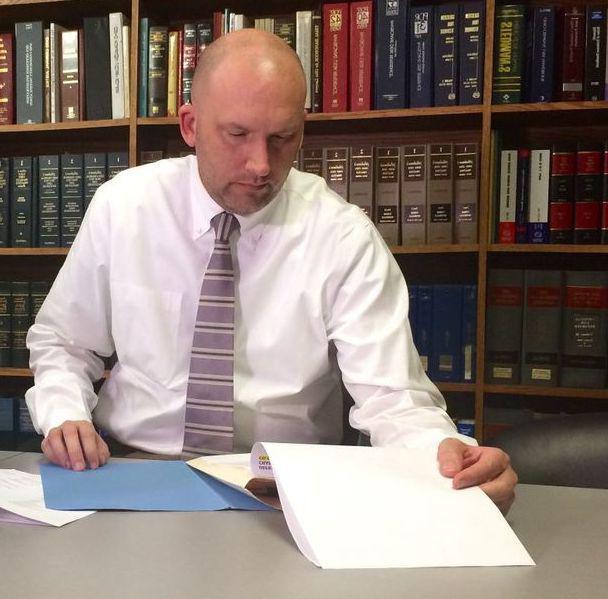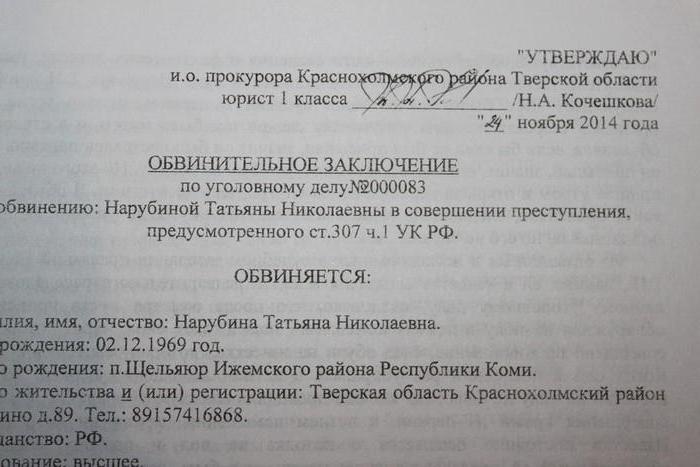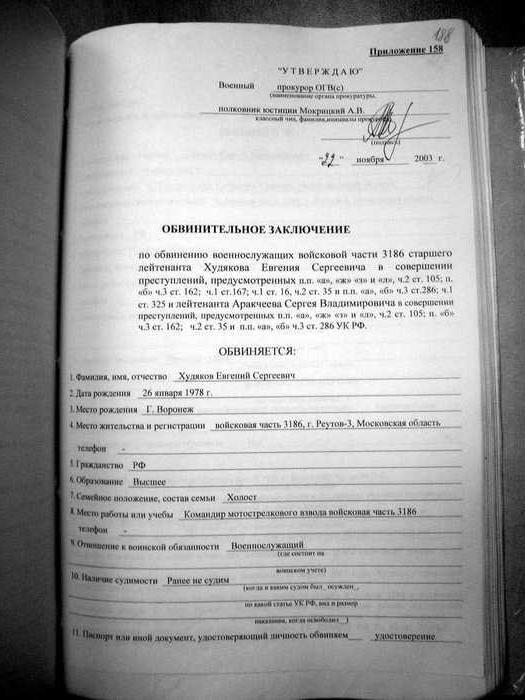One of the key objectives of criminal proceedings is the correct and objective application of the rule of law. It is inextricably linked to implementation. rule of law at all stages of the proceedings. Of particular legal importance is the indictment in a criminal case. It is this document that defines the scope of the proceedings in relation to both the subjects and the subject of the crime. Let us further consider in detail what constitutes a bill of indictment in a criminal case. A sample document will also be presented in the article. 
General information
The end of a criminal investigation is documented in a special document. Its content is subject to certain procedural requirements. They must be respected, otherwise it will not be referred to court. A document summarizing all the measures taken is provided for familiarization with the parties to the process. The accused, having received a conclusion, has the opportunity to prepare for the proceedings in a timely manner. The content of the document or its operative part shall be announced at the beginning of the meeting. This allows participants in the process, the composition of the court, the persons present at the hearing to understand the essence of the charges.
Characteristic
The indictment of the investigator in a criminal case acts as a procedural document, which systematizes and summarizes the information obtained in the course of clarifying the circumstances of the crime. It contains the conclusions reached by the official in the process of researching materials. For each crime, regardless of the number of entities participating in its commission, one indictment is drawn up.
Key requirements
Having completed the preliminary investigation, executive draws up a document in which are reflected:
- The essence of the crime with a description of all the circumstances that matter.
- Conclusions substantiated by the complex of evidence collected.
Systematization of information should be carried out sequentially and logically. The indictment in a criminal case cannot contain contradictions between:
- Conclusions and evidence.
- Documents and justification.
- Descriptive and motivational and concluding (resolute) parts.
- The qualification of the crime and the wording of the charge.

The content of the document should cover all unlawful acts, based on well-established circumstances. The information reflects the exact amount of the crime, the qualifications of each action in relation to a particular subject. The wording included in the indictment in a criminal case must comply with the information of the decision on holding a person liable. In some sources there is an indication of the admissibility of differences, if this does not violate the rights of the subject to protection.
Indictment in a criminal case: sample
In the document, the official indicates:
- FULL NAME. entities held liable.
- Information about the identity of each criminal.
- The essence of the charge, time, place of the act, goals, motives, ways, consequences. Other circumstances that matter may be indicated.
- The wording of the charge.In this case, the official must indicate the paragraph, part, article of the Criminal Code, which provides for the punishment for the committed act.
- A list of evidence that confirms the findings of an authorized employee who conducted the preliminary investigation. The officer summarizes their content.
- List of evidence submitted by the defense. They also need to be briefly described.
- Information about the victim, the amount and nature of the damage caused to him as a result of criminal acts.
- Information about civil defendants and plaintiffs.
The indictment in the criminal case also includes links to sheets and volumes of materials. The document is signed by the official who drafted it. In this case, the date and place of its execution shall be indicated.
Applications
In addition to the conclusion, the investigator compiles a list of persons to be summoned, both by the prosecution and the defense, indicating their place of residence or stay. The document also includes a statement of the selected preventive measures and the timing of their execution, physical evidence interim measures taken, civil action, procedural costs, possible confiscation of the suspected property, if the subject has dependents, about the measures taken to protect their rights. The paper indicates the relevant case sheets.
Sending a document to a higher authority
The indictment must be checked for compliance with procedural requirements. To do this, he is sent, together with materials and applications, to a higher authority. She is the prosecutor. In the cases provided for by Art. 18 of the CPC, the translation of documents is attached to the materials. Based on the results of the audit, the opinion of the prosecutor is drawn up. 
Official actions
After receiving the materials, the prosecutor should check:
- Is there really been an act that is charged with the subject, are there any signs of a crime in him.
- Are there any indications in the materials of circumstances leading to the end of the criminal case?
- Have all procedural actions been completed, have the studies been conducted objectively, comprehensively and fully.
- Do the charges justify the evidence presented in the case.
- Does the official’s findings cover all the facts established during the study of the circumstances.
- Are all persons convicted of a crime involved as defendants?
- Is the crime qualified correctly?
- Is the measure of restraint chosen correctly?
- Have measures been taken to ensure the requirements of the civil plaintiff and possible confiscation of the property brought to justice?
- Are the conditions and reasons that contributed to the commission of the crime clarified, and appropriate actions taken to eliminate them.
- Does the indictment comply with the requirements established in the CPC.
- Have the other legal requirements been complied with by officials?

Material Solution
In accordance with Art. 214 of the Code of Criminal Procedure, the prosecutor or his deputy must, within a period not exceeding five days, consider the case that came to them. Based on the results of the verification, one of the decisions is made. It may be:
- Approval of the indictment.
- The return of materials for the production of additional measures to clarify the circumstances of the crime.
- Ending the persecution.
- Return of materials for a new indictment.
If the document has not been approved by a higher authority, the materials are subject to transfer to officials who conducted operational search activities.
Descriptive part
She is considered the most time-consuming and difficult to indictment. Information related to the crime event, as well as to the behavior of the subjects involved in it, the circumstances that characterize the work of officials to identify all the facts of the incident, should be issued in a certain sequence. The implementation of this task requires high professionalism. The data set, which is included in the narrative, should provide an opportunity for the court to restore the whole picture of the committed illegal act. Authorized persons must have an idea of the identity of the subject being held accountable.The circumstances must be stated sequentially, logically. When describing them, the official should be based on reliable and admissible evidence. Any guesses and assumptions in the narrative are forbidden.
Key elements
They are called circumstances that are set out in the narrative of the conclusion. The absence of key elements in the content will indicate the inferiority of the document. As a rule, this situation is caused by gaps in the preliminary actions of the bodies of inquiry or investigation. This, in turn, violates the principle of comprehensiveness, completeness and objectivity of the study of all the circumstances of the incident. According to Art. 205 of the CPC, the key elements are indications of:
- The time and place of the act, motives, methods, consequences.
- Information about the victim.
- Evidence of crime and guilty citizen.
- Aggravating and mitigating circumstances.
- Arguments of the accused in his defense.
- Evidence verification results.

Recommendations
In complex cases, it is more advisable to begin the narrative with the characteristics of the crime, the group that participated in its commission, relations between subjects, ways of realizing unlawful intentions, the place of action, etc. In the process of presenting specific episodes, regardless of their number, the official must bring them in full scroll. The conclusion shall indicate the exact place where the act was committed. In some cases, investigators are limited to the name of the settlement, without mentioning the street, house or apartment numbers, or the location of the site on the ground. In cases in which this is possible, the exact time of the act should be indicated.
In some cases, you need to name it up to minutes. All information that is entered in the conclusion must be reflected in the case file. In some cases, officials do not show much interest in the motives of the perpetrator. In this regard, often in the conclusions there is no indication of the circumstances that prompted the subject to commit an act. A description of the consequences of the crime is also an integral element. When investigating cases against a person, the degree and nature of the severity of bodily harm shall be indicated without fail. In this case, the official refers to the conclusions of the medical expert. The indictment drawn up for property crimes must indicate the amount of damage caused or the value of the stolen property.